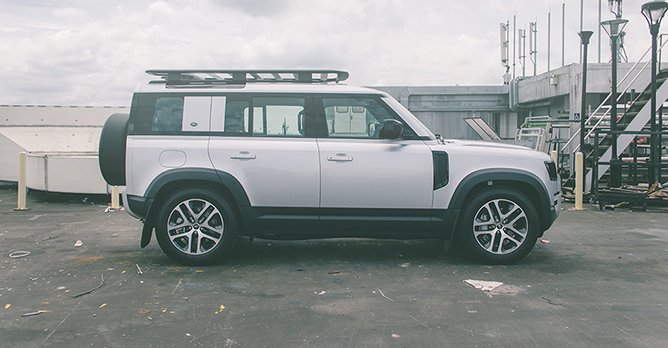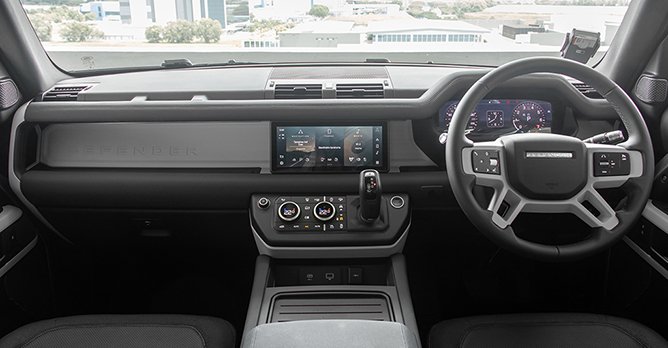Land Rover Defender 110 Review
08 Aug 2020|8,385 views
What We Like
It's a Land Rover Defender!
Agile and quick despite its size and heft
Perfect mix of ruggedness and modernity
Highly refined and tech savvy
What We Dislike
A little too pricey
Optional roof rails make the Defender impossible to enter most multi-storey carparks
You could say the Land Rover Defender was launched at a rather bad timing. Just as we were supposed to fly up to London for the international drive, COVID-19 happened and countries around the world were in lockdown. All of a sudden, the massive attention on one of the most iconic and important cars of the year has been diverted to more annoyingly persistent issues.
But bad timing or not, the car is here now and a proper on-road drive can finally take place. Unfortunately, during my time with the car, the most pertinent question cannot be answered due to land constraints - is the new Defender truly worthy of the iconic nameplate off the road?
That seems to be missing the point, no?

With the clever use of advanced technology, improved refinement and luxury feel, the car you see here has been catapulted into the current mix of modern-day opulent-looking SUVs when on the move.
It's simply startling when you're driving this car, almost like a betrayal of sorts where the agility of the Defender just doesn't seem to match the way it looks. It's no sports SUV, needless to say, but the precise steering wheel and the surprisingly well-controlled body do give you an idea of what's beneath the tyres.
 |  |
For a so-called hardcore off-roader that weighs over 2.3 tonnes, it's immensely quick.
But it's still essentially just an off-roader, yes?
Of course, enthusiasts and fans of the Defender (me included) will most likely shut critics (me included, again) up with the fact that a comfortable and refined drive isn't the Landie's priority. Still, we will have to accept yet another fact - it's the 21st century now and the basic requirement of a modern-day car from a modern-day carmaker is precisely comfort, if not some form of refinement.
And it's specifically because of these traits that make the Defender feel like a regular SUV and not some off-roader-only sort of truck, even if we didn't have the opportunity and space to take it off the beaten tracks.
But as far as I'm concerned, after driving the Defender, it's pretty safe to report that it doesn't come with any of the Suzuki Jimny's intrusiveness and none of the Jeep Wrangler's design complexity - although it's also unbiased to say that the Landie will be the most expensive of the three (estimated $281,999 for the 2.0-litre six-seater and $314,999 for the 3.0-litre First Edition MHEV).
Looks like it costs a lot more than that!
Thus, potential buyers will still be getting that sort of high-quality cabin that's associated with the Land Rover brand. At this price, you get a cabin that mixes modern luxury form with original rugged functionality.
On one hand, you get the sort of high-end tech such as the new Pivi Pro software on the 10-inch infotainment touchscreen system and leather-wrapped dash, but on the other, there are also exposed screw heads on the door panels and rubberised textured surfaces.
All these add up to make the entire cabin a rather unpretentious and rugged feel, but that may not be for everyone.
But it's crucial that we understand the immense pressure Land Rover had to face to create a brand new successor to what is already such an iconic vehicle. The car had to be somewhat similar without losing its strong and rich heritage, yet it had to be significantly different in order to be better than what it was and to stand out from its peers.
Hence, while the cabin isn't something we'd call premium despite its price tag, it has undoubtedly a perfect mix of form and function.
Take me home, to the off-road

Whichever you decide to choose, the Land Rover Defender is bound to be the sort of car that won't disappoint you. After all, people who buy this car are the ones who know what they want and how they want to spec their cars.
And just like them, I'll probably know how I want to spec my Defender. For one, I definitely won't be getting the optional roof rack (the height of the test car of over 2.1m with the optional roof rack made it painfully impossible to enter most sheltered carparks).
You could argue that most owners of a car like the Defender would probably have other cars to use should parking at malls and multi-storey carparks is required, and rightfully so. But thanks to vast up-to-date features and trendsetting looks that come with it, the new Landie here makes ownership of other vehicles seem almost pointless.
What We Like
It's a Land Rover Defender!
Agile and quick despite its size and heft
Perfect mix of ruggedness and modernity
Highly refined and tech savvy
What We Dislike
A little too pricey
Optional roof rails make the Defender impossible to enter most multi-storey carparks
You could say the Land Rover Defender was launched at a rather bad timing. Just as we were supposed to fly up to London for the international drive, COVID-19 happened and countries around the world were in lockdown. All of a sudden, the massive attention on one of the most iconic and important cars of the year has been diverted to more annoyingly persistent issues.
But bad timing or not, the car is here now and a proper on-road drive can finally take place. Unfortunately, during my time with the car, the most pertinent question cannot be answered due to land constraints - is the new Defender truly worthy of the iconic nameplate off the road?
That seems to be missing the point, no?

With the clever use of advanced technology, improved refinement and luxury feel, the car you see here has been catapulted into the current mix of modern-day opulent-looking SUVs when on the move.
It's simply startling when you're driving this car, almost like a betrayal of sorts where the agility of the Defender just doesn't seem to match the way it looks. It's no sports SUV, needless to say, but the precise steering wheel and the surprisingly well-controlled body do give you an idea of what's beneath the tyres.
Boot space in the five-seater configuration (left) is 857 litres - similar to the variant that will be sold to buyers here
Handling aside, the sheer power from the 48V mild hybrid 3.0-litre twin-charged in-line six-cylinder petrol powerplant is enough to impress. It shoots out 395bhp and 550Nm of twisting force to all wheels via an eight-speed gearbox, which allows the Defender to cross the 100km/h mark in just 6.1 seconds.For a so-called hardcore off-roader that weighs over 2.3 tonnes, it's immensely quick.
But it's still essentially just an off-roader, yes?
Of course, enthusiasts and fans of the Defender (me included) will most likely shut critics (me included, again) up with the fact that a comfortable and refined drive isn't the Landie's priority. Still, we will have to accept yet another fact - it's the 21st century now and the basic requirement of a modern-day car from a modern-day carmaker is precisely comfort, if not some form of refinement.
And it's specifically because of these traits that make the Defender feel like a regular SUV and not some off-roader-only sort of truck, even if we didn't have the opportunity and space to take it off the beaten tracks.
But as far as I'm concerned, after driving the Defender, it's pretty safe to report that it doesn't come with any of the Suzuki Jimny's intrusiveness and none of the Jeep Wrangler's design complexity - although it's also unbiased to say that the Landie will be the most expensive of the three (estimated $281,999 for the 2.0-litre six-seater and $314,999 for the 3.0-litre First Edition MHEV).
Looks like it costs a lot more than that!
Thus, potential buyers will still be getting that sort of high-quality cabin that's associated with the Land Rover brand. At this price, you get a cabin that mixes modern luxury form with original rugged functionality.
On one hand, you get the sort of high-end tech such as the new Pivi Pro software on the 10-inch infotainment touchscreen system and leather-wrapped dash, but on the other, there are also exposed screw heads on the door panels and rubberised textured surfaces.
All these add up to make the entire cabin a rather unpretentious and rugged feel, but that may not be for everyone.
But it's crucial that we understand the immense pressure Land Rover had to face to create a brand new successor to what is already such an iconic vehicle. The car had to be somewhat similar without losing its strong and rich heritage, yet it had to be significantly different in order to be better than what it was and to stand out from its peers.
Hence, while the cabin isn't something we'd call premium despite its price tag, it has undoubtedly a perfect mix of form and function.
Take me home, to the off-road

Whichever you decide to choose, the Land Rover Defender is bound to be the sort of car that won't disappoint you. After all, people who buy this car are the ones who know what they want and how they want to spec their cars.
And just like them, I'll probably know how I want to spec my Defender. For one, I definitely won't be getting the optional roof rack (the height of the test car of over 2.1m with the optional roof rack made it painfully impossible to enter most sheltered carparks).
You could argue that most owners of a car like the Defender would probably have other cars to use should parking at malls and multi-storey carparks is required, and rightfully so. But thanks to vast up-to-date features and trendsetting looks that come with it, the new Landie here makes ownership of other vehicles seem almost pointless.
Car Information
Land Rover Defender 110 Mild Hybrid 3.0 P400 First Edition (A)
CAT B|Petrol-Electric|10.1km/L
Horsepower
294kW (394 bhp)
Torque
550 Nm
Acceleration
6.1sec (0-100km /hr)
This model is no longer being sold by local distributor
All Used Land Rover Defender 110 Mild HybridThank You For Your Subscription.



























































